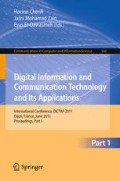Abstract
In this paper we propose a method for hiding a secret message in a digital image that is based on parsing the cover image instead of changing its structure. Our algorithm uses a divide-and-conquer strategy and works in Θ(nlogn) time. Its core idea is based on the problem of finding the longest common substring of two strings. The key advantage of our method is that the cover image is not modified, which makes it very difficult for any steganalysis technique based on image analysis to detect and extract the message from the image.
Access this chapter
Tax calculation will be finalised at checkout
Purchases are for personal use only
Preview
Unable to display preview. Download preview PDF.
References
Cachin, C.: An information-theoretic model for steganography. In: Aucsmith, D. (ed.) IH 1998. LNCS, vol. 1525, pp. 306–318. Springer, Heidelberg (1998)
Cormen, Leiserson, Rivest, Stein.: Introduction to algorithms, 2nd edn. The MIT press, Cambridge (2001)
Dunbar, B.: A detailed look at steganographic techniques and their use in an open-systems environment. Sans InfoSec Reading Room (2002)
Fridrich, J., Pevný, T., Kodovský, J.: Statistically undetectable jpeg steganography: dead ends challenges, and opportunities. In: Proceedings of the 9th Workshop on Multimedia & Security, pp. 3–14. ACM, New York (2007)
Gusfield, D.: Algorithms on strings, trees, and sequences. Cambridge university press, Cambridge (1997)
Huaiqing, W., Wang, S.: Cyber warfare: Steganography vs. steganalysis. Communications of the ACM 47(10), 76–82 (2004)
Fridrich, M.G.J.: Practical steganalysis of digital images - state of the art. Security and Watermarking of Multimedia Contents IV 4675, 1–13 (2002)
Johnson, N., Jajodia, S.: Steganalysis of images created using current steganography software. In: Workshop on Information Hiding (1998)
Johnson, N., Jajodia, S.: Steganalysis: The investigation of hidden information. In: Proc. of the 1998 IEEE Information Technology Conference (1998)
Katzenbeisser, Petitcolas: Information hiding: Techniques for steganography and watermarking. Artech House, Boston (2000)
Ker, A.D.: A fusion of maximum likelihood and structural steganalysis. In: Furon, T., Cayre, F., Doërr, G., Bas, P. (eds.) IH 2007. LNCS, vol. 4567, pp. 204–219. Springer, Heidelberg (2008)
Krenn, R.: Steganography and steganalysis. Whitepaper (2004)
Lee, K., Westfeld, A., Lee, S.: Generalised category attack—improving histogram-based attack on JPEG LSB embedding. In: Furon, T., Cayre, F., Doërr, G., Bas, P. (eds.) IH 2007. LNCS, vol. 4567, pp. 378–391. Springer, Heidelberg (2008)
Lin, E.T., Delp, E.J.: A review of data hiding in digital images. In: Proceedings of the Image Processing, Image Quality, Image Capture Systems Conference (1999)
Shirali-Shahreza, M., Shirali-Shahreza, S.: Collage steganography. In: Proceedings of the 5th IEEE/ACIS International Conference on Computer and Information Science (ICIS 2006), Honolulu, HI, USA, pp. 316–321 (July 2006)
Upham, D.: Steganographic algorithm JSteg, http://zooid.org/paul/crypto/jsteg
Westfeld, A., Pfitzmann, A.: Attacks on steganographic systems. In: Pfitzmann, A. (ed.) IH 1999. LNCS, vol. 1768, pp. 61–76. Springer, Heidelberg (2000)
Yu, X., Wang, Y., Tan, T.: On estimation of secret message length in jsteg-like steganography. In: Proceedings of the Pattern Recognition, 17th International Conference on (ICPR 2004), pp. 673–676. IEEE Computer Society, Los Alamitos (2000)
Zahedi Kermani, M.J.Z.: A robust steganography algorithm based on texture similarity using gabor filter. In: IEEE 5th International Symposium on Signal Processing and Information Technology (2005)
Zhang, T., Ping, X.: A fast and effective steganalytic technique against jsteg-like algorithms. In: SAC 2003, pp. 307–311. ACM, New York (2003)
Author information
Authors and Affiliations
Editor information
Editors and Affiliations
Rights and permissions
Copyright information
© 2011 Springer-Verlag Berlin Heidelberg
About this paper
Cite this paper
Farhat, H., Challita, K., Zalaket, J. (2011). Static Parsing Steganography. In: Cherifi, H., Zain, J.M., El-Qawasmeh, E. (eds) Digital Information and Communication Technology and Its Applications. DICTAP 2011. Communications in Computer and Information Science, vol 166. Springer, Berlin, Heidelberg. https://doi.org/10.1007/978-3-642-21984-9_41
Download citation
DOI: https://doi.org/10.1007/978-3-642-21984-9_41
Publisher Name: Springer, Berlin, Heidelberg
Print ISBN: 978-3-642-21983-2
Online ISBN: 978-3-642-21984-9
eBook Packages: Computer ScienceComputer Science (R0)

